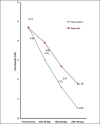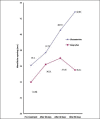Evaluation of Glucosamine sulfate and Ibuprofen effects in patients with temporomandibular joint osteoarthritis symptom
- PMID: 24991602
- PMCID: PMC4076897
- DOI: 10.4103/2279-042X.114087
Evaluation of Glucosamine sulfate and Ibuprofen effects in patients with temporomandibular joint osteoarthritis symptom
Abstract
Objective: Ibuprofen - a non-steroidal anti-inflammatory drug (NSAID)- and glucosamine sulfate - a natural compound and a food supplement- are two therapeutic agents which have been widely used for treatment of patients with temporomandibular joint (TMJ) disorders. This study was aimed to compare the effectiveness and safety of these two medications in the treatment of patients suffering from TMJ disorders.
Methods: After obtaining informed consent, 60 patients were randomly allocated to two groups. Patients with painful TMJ, TMJ crepitation or limitation of mouth opening entered the study. Exclusion criteria were history of depressive disorders, cardiovascular disease, musculoskeletal disorders, asthma, gastrointestinal problems, kidney or liver dysfunction or diabetes mellitus, dental diseases needing ongoing treatment; taking aspirin or warfarin, or concomitant treatment of TMJ disorder with other agents or methods. Thirty patients were treated with ibuprofen 400 mg twice a day, (mean age 27.12 ± 10.83 years) and 30 patients (mean age 26.60 ± 10) were treated with glucosamine sulfate 1500 mg daily. Patients were visited 30, 60 and 90 days after starting the treatment, pain and mandibular opening were checked and compared within and between two groups.
Findings: Comparing with baseline measures, both groups had significantly improved post-treatment pain (P < 0.0001 for both groups) and mandibular opening (P value: 0.001 for glucosamine sulfate and 0.03 for ibuprofen). Post treatment pain and mandibular opening showed significantly more improvement in the glucosamine treated patients (P < 0.0001 and 0.01 respectively). Rate of adverse events was significantly lower in the P value glucosamine sulfate group (P < 0.0001).
Conclusion: This investigation demonstrated that comparing with a commonly prescribed NSAID - ibuprofen-, glucosamine sulfate is a more effective and safer therapeutic agent for treatment of patients with TMJ degenerative join disorder.
Keywords: Glucosamine sulfate; ibuprofen; temporomandibular joint disorder.
Conflict of interest statement
Figures
Similar articles
-
Efficiency of Glucosamine in Treating Temporomandibular Joint Osteoarthritis: A Meta-Analytic Umbrella Review.Curr Rheumatol Rev. 2025;21(2):194-201. doi: 10.2174/0115733971309907240527105306. Curr Rheumatol Rev. 2025. PMID: 38867545
-
Evaluation of glucosamine sulfate compared to ibuprofen for the treatment of temporomandibular joint osteoarthritis: a randomized double blind controlled 3 month clinical trial.J Rheumatol. 2001 Jun;28(6):1347-55. J Rheumatol. 2001. PMID: 11409130 Clinical Trial.
-
Does glucosamine, chondroitin sulfate, and methylsulfonylmethane supplementation improve the outcome of temporomandibular joint osteoarthritis management with arthrocentesis plus intraarticular hyaluronic acid injection. A randomized clinical trial.J Craniomaxillofac Surg. 2021 Aug;49(8):711-718. doi: 10.1016/j.jcms.2021.02.012. Epub 2021 Feb 22. J Craniomaxillofac Surg. 2021. PMID: 33685850 Clinical Trial.
-
There seems to be similar improvement in pain and mouth opening limitation when comparing glucosamine supplements with a placebo or ibuprofen in patients with temporomandibular joint osteoarthritis.J Am Dent Assoc. 2018 Oct;149(10):e135. doi: 10.1016/j.adaj.2018.03.009. Epub 2018 May 22. J Am Dent Assoc. 2018. PMID: 29801932 No abstract available.
-
Nutraceuticals as therapeutic agents in osteoarthritis. The role of glucosamine, chondroitin sulfate, and collagen hydrolysate.Rheum Dis Clin North Am. 1999 May;25(2):379-95. doi: 10.1016/s0889-857x(05)70074-0. Rheum Dis Clin North Am. 1999. PMID: 10356424 Review.
Cited by
-
Adenosine-Functionalized Biodegradable PLA-b-PEG Nanoparticles Ameliorate Osteoarthritis in Rats.Sci Rep. 2019 May 15;9(1):7430. doi: 10.1038/s41598-019-43834-y. Sci Rep. 2019. PMID: 31092864 Free PMC article.
-
Efficiency of Glucosamine in Treating Temporomandibular Joint Osteoarthritis: A Meta-Analytic Umbrella Review.Curr Rheumatol Rev. 2025;21(2):194-201. doi: 10.2174/0115733971309907240527105306. Curr Rheumatol Rev. 2025. PMID: 38867545
-
Pharmacological Treatments of Temporomandibular Disorders: A Systematic Review Including a Network Meta-Analysis.Drugs. 2024 Jan;84(1):59-81. doi: 10.1007/s40265-023-01971-9. Epub 2023 Dec 16. Drugs. 2024. PMID: 38103150 Free PMC article.
-
Effects of Glucosamine in the Temporomandibular Joint Osteoarthritis: A Review.Curr Rheumatol Rev. 2024;20(4):373-378. doi: 10.2174/0115733971283009231225144322. Curr Rheumatol Rev. 2024. PMID: 38213156 Review.
-
Nutritional Strategies for Chronic Craniofacial Pain and Temporomandibular Disorders: Current Clinical and Preclinical Insights.Nutrients. 2024 Aug 27;16(17):2868. doi: 10.3390/nu16172868. Nutrients. 2024. PMID: 39275184 Free PMC article. Review.
References
-
- Guarda-Nardini L, Ferronato G, Favero L, Manfredini D. Predictive factors of hyaluronic acid injections short-term effectiveness for TMJ degenerative joint disease. J Oral Rehabil. 2011;38:315–20. - PubMed
-
- Milam SB. Pathophysiology and epidemiology of TMJ. J Musculoskelet Neuronal Interact. 2003;3:382–90. - PubMed
-
- Tanaka E, Detamore MS, Mercuri LG. Degenerative disorders of the temporomandibular joint: Etiology, diagnosis, and treatment. J Dent Res. 2008;87:296–307. - PubMed
-
- Fricton J. Current evidence providing clarity in management of temporomandibular disorders: Summary of a systematic review of randomized clinical trials for intra-oral appliances and occlusal therapies. J Evid Based Dent Pract. 2006;6:48–52. - PubMed
LinkOut - more resources
Full Text Sources
Other Literature Sources




